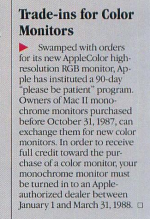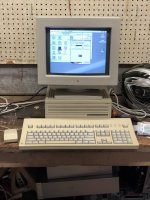Looking at the documentation and screenshots of the IIe card in action it looks to me like that 560x384 resolution is *only* in play if you have the 12" monitor, if you have any other monitor on your LC the Apple II display gets letterboxed into the middle. (There's nothing in the manual about limitations on the attached monitor when using the card, so in principle it probably works even if you have the Portrait display attached.) The 560x384 mode doesn't require any "multi-syncing" on the part of the monitor, it has the same hsync and vsync as the 512 pixel wide mode, it just has a slightly higher dot clock. It makes sense that this mode is only accessible when a IIe card is installed because the result would be non-square pixels, which doesn't matter with Apple II software (they're already not square on the real thing), but a big no-no for Macs.
Honestly I don't know what the logic behind Apple offering that 12" monitor in the first place was. My vague recollection of what I've read about it (and the similar resolution limitation of the Color Classic) is that it was generally a bad choice from a Macintosh application perspective because despite being the same width as the B&W Macs' screens it wasn't really any more compatible with software targeted at the toasters (because the underlying video memory arrangement is still vastly different) *and* it also caused problems with color software because up until the LC the minimum expected resolution for a Mac II was 640x480, and some software broke when presented with less. The one positive attribute it has is the 12" can display 256 colors with the default 256k of VRAM, which would be useful for educational software explicitly targeted at that configuration.
Given the rarity of the monitor itself I wonder how vanishingly rare the 1-bit monochrome video card they apparently sold to only the most extreme cheapskates was. I actually didn't even know this card existed, I always assumed that the standard "mono" Mac IIwhatever configuration consisted of a Toby-style video card with at least 16 grays. This card appears to essentially be the SE/30's video (at the higher 640x480 resolution) on a card. Anyone actually have one?
A couple technical descriptions of the IIe card I've read say that the way it displays video is by notifying the Mac software whenever there's a screen update in its private buffer, and then said buffer is manually copied to the VRAM, there's no overlay function. That jives with reports of screen updates "lagging" compared to a real Apple IIe; an overlay system wouldn't have this problem.probably a blank windowed feed like how the TV-Tuner display piped directly into the Mac environment as Video was displayed in a "blank" window that shows up in bluescreen on a screenshot.
Honestly I don't know what the logic behind Apple offering that 12" monitor in the first place was. My vague recollection of what I've read about it (and the similar resolution limitation of the Color Classic) is that it was generally a bad choice from a Macintosh application perspective because despite being the same width as the B&W Macs' screens it wasn't really any more compatible with software targeted at the toasters (because the underlying video memory arrangement is still vastly different) *and* it also caused problems with color software because up until the LC the minimum expected resolution for a Mac II was 640x480, and some software broke when presented with less. The one positive attribute it has is the 12" can display 256 colors with the default 256k of VRAM, which would be useful for educational software explicitly targeted at that configuration.
The logical reason why the 12" mono display would be rare is that when you're spending the five grand-ish that a complete II-series Mac setup cost in 1989 it probably doesn't make a whole lot of sense to miss out on having a color display, given that's only going to save you around 10% of the total purchase cost. Might as well just buy an SE/30 instead.I don't even feel like the 12" monochrome display from the Mac II era was very popular, I've never seen one in person.
And, thinking about it, I'm pretty certain that the 12" monochrome display as I found it on vectronics is the one.
Given the rarity of the monitor itself I wonder how vanishingly rare the 1-bit monochrome video card they apparently sold to only the most extreme cheapskates was. I actually didn't even know this card existed, I always assumed that the standard "mono" Mac IIwhatever configuration consisted of a Toby-style video card with at least 16 grays. This card appears to essentially be the SE/30's video (at the higher 640x480 resolution) on a card. Anyone actually have one?


